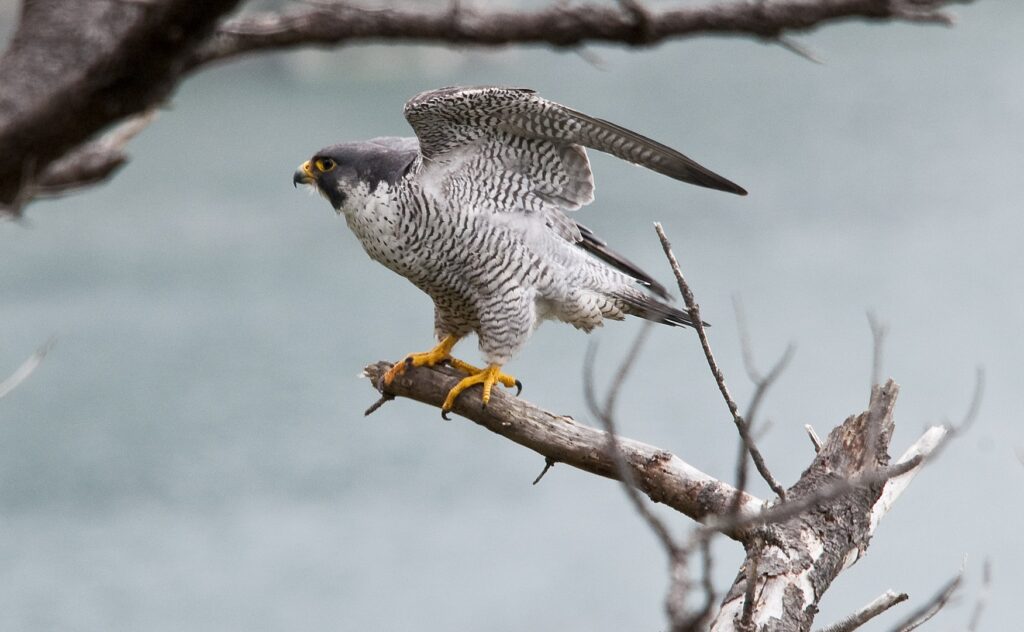Lorem ipsum dolor sit amet, consectetur adipiscing elit. Ut elit tellus, luctus nec ullamcorper mattis, pulvinar dapibus leo.
Neat to know ~ Creature of the week
Lorem ipsum dolor sit amet, consectetur adipiscing elit. Ut elit tellus, luctus nec ullamcorper mattis, pulvinar dapibus leo.

Peregrine Falcon, Cape Meares, Oregon, USA
The Peregrine Falcon
2020-11-15
– The peregrine falcon is a bird of prey, or a “raptor.” Like all raptors, the peregrine has a sharp hooked beak and powerful talons that can grab and carry prey while in flight.
– Despite having been near extinction less than 100 years ago, peregrines are now widespread and can be found on every continent, except Antarctica. They have adapted to all kinds of habitats, including tundra, desert, woodlands, coastlines, mountains, and even cities, where they have been seen nesting on the sides of skyscrapers.
– Except during breeding times, peregrines live mostly solitary lives.
Read on to learn more about the swift and resilient peregrine falcon.
Explosive speed
- Peregrine falcons normally travel at speeds ranging from 40 to 65 mph (64-104 kph). They sometimes hunt their prey – usually other birds – simply by chasing it. But they aren’t always successful, since the birds they pursue are also fast. So peregrines often use a different method of catching prey. They fly high up into the sky and use their sharp eyes to spot potential targets as far as a mile away. After climbing even higher, they turn and dive, pinning their pointed wings close to their bodies and becoming ultra-streamlined. During their dives, they can reach speeds of almost 200 mph (321 kph), making them the fastest animals on earth. As they get closer to their prey, they open their wings to slow themselves down, and seize the animal in the ultimate surprise attack.
- The nostrils of peregrines contain special structures that keep air from rushing into their lungs too quickly when they are moving at top speeds. Without these structures, called baffles, the bird’s lungs would explode from the force of the air.
- Peregrines’ eyes have evolved to handle the stresses of moving through the air at such high speeds. An additional eyelid – a thin, transparent membrane – slips over the eye to keep it clear of debris and prevent it from drying out during flight.
- Not only are they fast, they are also precise and agile. Peregrines seize their prey in midair!
Top of the food chain
- Few animals can compete with the peregrine falcon when it comes to their dominance as powerful hunters. Sometimes, baby peregrines fall prey to larger birds, but adult peregrines are threatened only by humans.
- These falcons eat other birds – and a remarkable variety of birds at that, possibly around 2000 species worldwide. Most often, they consume gulls, ducks, pigeons, and songbirds.
- Peregrines’ diet is not limited to birds. If the opportunity arises, they may consume rodents, bats, and fish as well.
The wanderer
- The name for the peregrine falcon comes from the Latin word “peregrinus,” meaning “wanderer.” While certain peregrines, like the ones that make their homes in cities, stay put throughout the year, others migrate thousands of miles, from the Arctic, where they nest, to South America, where they spend winters. In total, this yearly migration is around 15,500 miles (25,944 km).
- Despite their long journeys, migrating peregrine falcons keep returning to the same nesting sites, year after year. Mates stay together for life, but they don’t migrate together. This means, that after journeying thousands of miles and spending months apart, they are able to find each other and their nests again each year. It has been observed that some nesting sites have stayed in the same family for generations.
- These falcons often nest high up on cliffs. Instead of building nests with sticks, they scrape indentations into the sides of cliffs. They may sometimes use abandoned stick nests from other birds, too.
Other peregrine facts
- Peregrine falcons are not brightly colored and generally blend into their surroundings. The head and back are a dark gray-brown, while the wings and tail are usually blue-gray and the neck is white. Under the wings and on the white chest are dark stripes. The skin around the eyes and the talons are yellow.
- Peregrines are one to two feet tall (30-60 c). Their wingspan is about 3.5 feet (1 meter).
- As is the case with most birds of prey, males are only about 1/3 the size of females.
- Peregrine falcons mate for life. Both parents help to raise the young. One might go out to hunt while the other stays home with the babies. The pair works together until the young are no longer so vulnerable.
- Peregrine falcons can live for 15 years or more.
- These birds almost went extinct in the mid-1900s. Besides being shot and killed, they were also poisoned by certain types of pesticides that were used at the time. Luckily, they were put on the endangered species list and given protection. In the meantime, the pesticides that had killed so many of them was outlawed and the peregrine made an astounding comeback. It is now the most common bird of prey in the world. And by some estimates, there are more peregrine falcons now than there were before they became endangered.
Sources: National Geographic, “Peregrine Falcon,” https://www.nationalgeographic.com/animals/birds/p/peregrine-falcon/; The National Wildlife Federation, “Peregrine Falcon,” https://www.nwf.org/Educational-Resources/Wildlife-Guide/Birds/Peregrine-Falcon; The Nature Conservancy, “Peregrine Falcon-Nature’s finest flying machine,” https://www.nature.org/en-us/about-us/where-we-work/united-states/indiana/stories-in-indiana/peregrine-falcons/; Kiff, Lloyd, Britannica, “Peregrine falcon,” https://www.britannica.com/animal/peregrine-falcon.